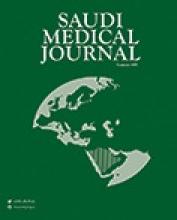Abstract
OBJECTIVE: Hemophilus influenzae is an important pathogen that is responsible for invasive and non-invasive infections in both children and adults. This study aims to assess the relationship of biotypes to the sites of infection, serotypes, antimicrobial susceptibility, b-lactamase production and age.
METHODS: A total of 200 isolates of H.influenzae were obtained from clinical specimens over a period of 12 months from January 2001 through to January 2002 from King Abdul-Aziz University Hospital, Riyadh, Kingdom of Saudi Arabia.
RESULTS: Most of the strains were non-typable and were isolated from patients with non-invasive infections. The typable isolates from invasive infections mostly serotype b were isolated from blood, cerebrospinal fluid and hip joint aspirate. Biotype II accounted for 37% of the isolates followed by biotypes III and I (29.5% and 23%). The remaining 10.5% were made up of biotypes IV, V, VI and VII. A significantly high resistance to cotrimoxazole (33.5%) and ampicillin (19%) was observed. Two point five percent of the isolates were resistant to chloramphenicol. All the isolates resistant to ampicillin were b-lactamase producers and susceptible to cefuroxime, ceftriaxone, ciprofloxacin and rifampicin.
CONCLUSION: This study revealed that biotypes II and III are the predominant biotypes of H.influenzae found in non-invasive infections. There is an apparent relationship between biotype and site of infection which could be useful as an epidemiological marker.
- Copyright: © Saudi Medical Journal
This is an open-access article distributed under the terms of the Creative Commons Attribution-Noncommercial-Share Alike 3.0 Unported, which permits unrestricted use, distribution, and reproduction in any medium, provided the original work is properly cited.






